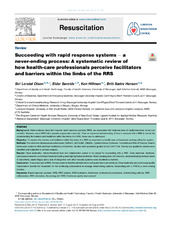| dc.contributor.author | Olsen, Siri Lerstøl | en_US |
| dc.contributor.author | Søreide, Eldar | en_US |
| dc.contributor.author | Hillman, Ken | en_US |
| dc.contributor.author | Hansen, Britt Sætre | en_US |
| dc.date.accessioned | 2020-06-08T09:36:38Z | |
| dc.date.available | 2020-06-08T09:36:38Z | |
| dc.date.issued | 2019-11 | |
| dc.Published | Olsen SL, Søreide E, Hillman, Hansen BS. Succeeding with rapid response systems - a never-ending process: A systematic review of how health-care professionals perceive facilitators and barriers within the limbs of the RRS. Resuscitation. 2019;144:75-90 | eng |
| dc.identifier.issn | 0300-9572 | |
| dc.identifier.issn | 1873-1570 | |
| dc.identifier.uri | https://hdl.handle.net/1956/22484 | |
| dc.description.abstract | Background: Meta-analyses show that hospital rapid response systems (RRS) are associated with reduced rates of cardiorespiratory arrest and mortality. However, many RRS fail to provide appropriate outcomes. Thus an improved understanding of how to succeed with a RRS is crucial. By understanding the barriers and facilitators within the limbs of a RRS, these can be addressed. Objective: To explore the barriers and facilitators within the limbs of a RRS as described by health-care professionals working within the system. Methods: The electronic databases searched were: EMBASE, MEDLINE, CINAHL, Epistemonikos, Cochrane, PsychInfo and Web of Science. Search terms were related to RRS and their facilitators and barriers. Studies were appraised guided by the CASP tool. Twenty-one qualitative studies were identified and subjected to content analysis. Results: Clear leadership, interprofessional trust and collaboration seems to be crucial for succeeding with a RRS. Clear protocols, feedback, continuous evaluation and interprofessional training were highlighted as facilitators. Reprimanding down the hierarchy, underestimating the importance of call-criteria, alarm fatigue and a lack of integration with other hospital systems were identified as barriers. Conclusion: To succeed with a RRS, the keys seem to lie in the administrative and quality improvement limbs. Clear leadership and continuous quality improvement provide the foundation for the continuing collaboration to manage deteriorating patients. Succeeding with a RRS is a never-ending process. | en_US |
| dc.language.iso | eng | eng |
| dc.publisher | Elsevier | eng |
| dc.rights | Attribution-NonCommercial-NoDerivs CC BY-NC-ND | eng |
| dc.rights.uri | https://creativecommons.org/licenses/by-nc-nd/4.0/ | eng |
| dc.subject | Rapid response systems | eng |
| dc.subject | RRS | eng |
| dc.subject | RRS barriers | eng |
| dc.subject | RRS facilitators | eng |
| dc.subject | Healthcare professional perceptions | eng |
| dc.subject | Deteriorating patients | eng |
| dc.subject | RRS collaboration | eng |
| dc.subject | RRS simulation | eng |
| dc.subject | Succeding with RRS | eng |
| dc.subject | Continous quality improvement | eng |
| dc.title | Succeeding with rapid response systems - a never-ending process: A systematic review of how health-care professionals perceive facilitators and barriers within the limbs of the RRS | en_US |
| dc.type | Peer reviewed | |
| dc.type | Journal article | |
| dc.date.updated | 2020-02-05T14:44:31Z | |
| dc.description.version | publishedVersion | en_US |
| dc.rights.holder | Copyright 2019 The Author(s) | |
| dc.identifier.doi | https://doi.org/10.1016/j.resuscitation.2019.08.034 | |
| dc.identifier.cristin | 1745736 | |
| dc.source.journal | Resuscitation | |
| dc.relation.project | Universitetet i Stavanger: 5091 | |

